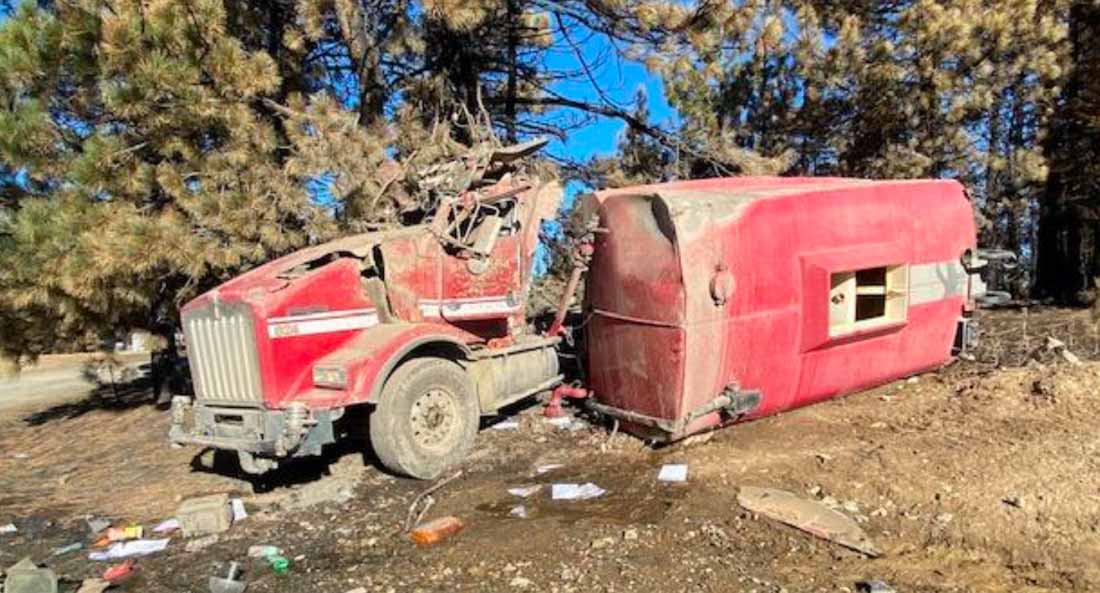
This is the 66th article on Wildfire Today about rollovers of wildland fire vehicles. But, it is the first we have heard about in 2020.
From the Wildland Fire Lessons Learned Center:
At approximately 0755 hours on September 27th, August Complex South Zone communications was notified of a Water Tender accident via radio by another Water Tender Operator who was also working in the area.
The Water Tender involved in the accident was full with approximately 4,000 gallons of water being utilized for road dust abatement.
Before experiencing radio challenges, the first Water Tender on scene was able to notify communications that there had been an accident and the Water Tender Operator had an injury to the shoulder, back and neck.
It is unknown if the driver was ejected from the vehicle during the accident, but the first water tender on scene did observe the driver climbing out from underneath the front bumper area of the wreckage.
Due to the accident’s location and lack of clarity of the nature of the accident/injuries, the Incident Management Team started a Life Flight response per the Medical and Incident Within an Incident (IWI) Plan. Upon activating the local Life Flight care provider, it was determined that the closest two helicopters were unavailable due to maintenance issues, leaving the third option of an ETA of 35 minutes. The decision was made to utilize the exclusive use Helicopter 514, staffed with an EMT, to transport the paitient with a 10 minute ETA.
A Safety Officer assigned to the incident arrived on scene, provided a size-up of the incident and assumed command of the IWI. When units arrived on scene, the Water Tender was upright, resting on its wheels against a tree with its tank separated from the chassis.
The area of the accident had a suitable landing spot. The patient was loaded into the helicopter and taken to the local trauma center for evaluation.

LESSONS
- Always take the time to put on your seatbelt. This should be a given because it is a state law, but in a rush to accomplish a task or when a task is short duration, clicking a seatbelt can get skipped. A properly worn seatbelt can reduce injuries during an unintended outcome.
- It is critical for any vehicle operator to keep vehicles at a reduced speed to the extent possible while vehicles are under heavy load driving on surfaces with increased stopping distances.
- Beware of soft shoulders, narrow sections, blind corners, compromised visibility, and distractions— any combination of these conditions is especially dangerous.
- Given the frequency with which water tenders roll on wildland fires, be very judicious about assigning work for tenders. Always ask: “Is this mission necessary?”
The Wildland Fire Lessons Learned Center has reports for 13 Water Tender Rollovers from 2015 to 2020.

The wife and I just got back from a long backroads camping trip to Montana. Montana DOT places white crosses at the scene of fatal accidents. While it’s disheartening to see one cross, there there some places in Montana where three, four, or five crosses are placed, and on some sections of road there were multiple crosses within a quarter mile.
What’s the consistent location of many of these crosses? The outside radius of a bend in the road. And for the most part these weren’t high speed roads. There were plenty of crosses on 45 MPH country roads.
A heavy water truck carrying a liquid, shifting load is hard enough to manage in a straight line. Throw in a curve in the road and unless you slow the heck down, the inertia of your truck will retain its state of velocity along a straight line and you’ll wind up rolling your truck.